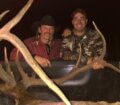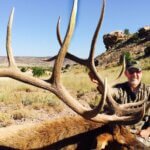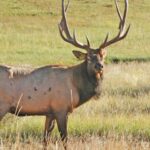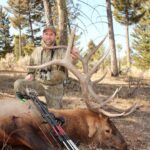Editor’s Note: “Colorado Buck” Ward lives in Texas on his cattle ranch. He’s been hunting and guiding for elk since 1985 and knows what’s required to hunt bull elk successfully.

Calling Elk
Ward explains, “I’ve used a wide variety of different elk calls in years past. But a few years back, I got to hunt with David Hale and Harold Knight, the founders of Knight and Hale Game Calls. I liked their elk calls, and I liked them as people. I took them to take the very first bull elk they’d ever bagged. So, I use their calls primarily.
“Since we’re on the subject of elk calls, I use elk calls sparingly. I mainly use an elk call as a distance locator. I believe that breaking brush, rubbing trees, walking like an elk, and glunking are much more productive sounds when trying to call in a mature bull than cow calling or bugling. I think old, mature bulls can recognize a cow call or a bugle just like we can recognize each other’s voices. I know that the natural sounds that elk make are not used as often as calls are. That’s why I feel we have a better chance of taking a mature bull than if we use calls like everyone else and get the same results most people get.”
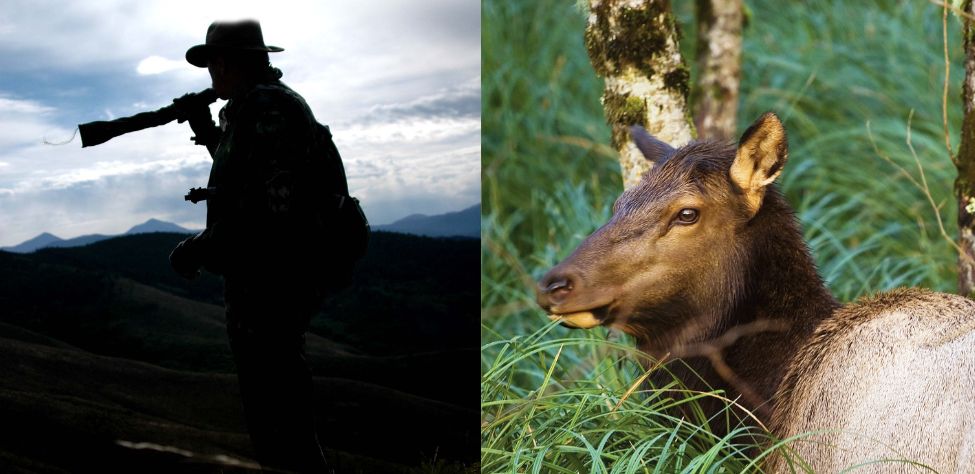
- Getting Elk Out: One of the problems with elk hunting is that after you squeeze the trigger, the fun’s over. How do you get your elk out when your clients take an elk? According to Ward, “We use a four-wheeler or a truck or any vehicle we can drive close enough to the animal to get him out,” Ward reports. “We don’t use horses or mules that may wake up in a bad mood and throw clients off their backs, kick them, and/or bite them. If we’re deep in the woods, we’ll butcher the elk and carry the meat and the head out in backpacks.”
- Taking Bears and Mule Deer: Ward also guides bears and mule deer. “On our last hunt in the fall of 2023, we shot our 20th bear for the season. One of the reasons we encourage our hunters to get a bear tag is because we’ve studied the cow elk. If you see six cows, and there’s only one calf in that group, you don’t have to be the sharpest knife in the drawer to understand there’s a problem with predators killing and eating the calves. Two years ago, I was seeing one calf for every six cows. We’ve been trying to harvest bears on our elk hunts, and this year we’re seeing four calves with every six cows.
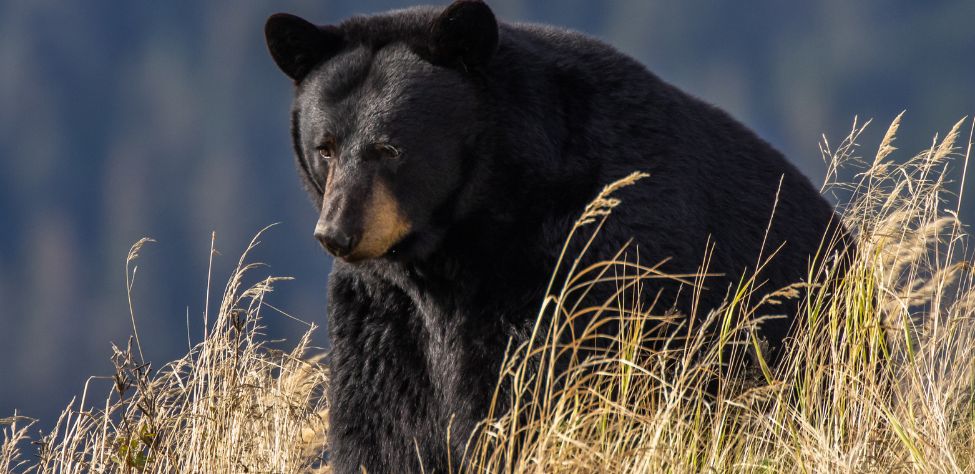
“One bear can kill five or six calves in the spring if they live where the cow elk are calving. I don’t charge extra for a person who buys a bear tag to go along with his elk tag because I know that by encouraging our hunters to take bears, we’re increasing the population of elk we have on the properties we hunt.”
To contact “Colorado Buck” Ward, call 1-800-355-8247.


Expert Guidebooks on Elk Hunting: Best Sellers

Secrets for Hunting Elk
The quickest, easiest (if there is an easy way), and safest way to find and take that bull elk of a lifetime will be to hunt with a guide.
Chad Schearer, a longtime Montana guide and TV personality, told me, “My hunter is my gun. If I get to the elk, and my hunter isn’t with me, then we don’t take the elk. My job is not only to find the elk but also to help the hunter get to the elk and make the experience as enjoyable as I can for him.” That’s the kind of fella with whom I want to go elk hunting.
An elk hunt can be tough, but it doesn’t have to be so tough that you don’t enjoy it. That’s why this elk hunting book starts with the confessions of an elk guide and with Chad Schearer’s philosophy of what the guide and the hunter’s relationship should be.
A good portion of your success will depend on your physical condition, and Matt Morrett of Harrisburg, Pennsylvania explains how an eastern hunter can get ready physically during June and July to hunt western elk, the animals he describes as, “Like deer or turkeys on steroids.”
Wayne Carlton, well-known elk hunter and TV and video personality from Montrose, Colorado, tells us what types of elk calls to use and what to say to the elk. Mike Miller of Colorado, another elk guide and Mossy Oak video personality, has tactics for the best equipment for bowhunting and gun hunting elk.
You’ll learn helpful strategies and hunting tips in this book, as well as some straightforward hunting methods that will help to make your elk hunt more successful.
“Thanks to the advice in your elk hunting books, I was able to call up a nice 6-point (6X6) bull elk! He was bugling like crazy. I called him in from about a ¼ mile away. Called him into bow range (about 40 yards away). It was a thrill!” ~Rob Brannon
VERSIONS: AUDIBLE & KINDLE

Elk: Keys to 25 Hunters’ Success
Often just one tip or tactic makes the difference in whether you take an elk home to dinner or have to hike back to the truck by yourself. In John E. Phillips’ latest elk book, Elk: Keys to 25 Hunters’ Success, you’ll learn from successful elk hunters the strategies they use to find and take elk.
Many know that the technique that seems to work most often is to hunt where other elk hunters don’t and understand where the elk are before you go on a hunt by studying data from each state, visiting HuntData (see chapter 1), examining maps, and reading postings on elk forums.
This book also tells you how to get ready physically for an elk hunt, including participating in Train to Hunt Competitions, what gear you need to take, how to enjoy a successful do-it-yourself elk hunt, or how to pick the best elk guide for you. You’ll also hear about the X System and the Broken Y System of hunting elk.
Although no one person has all the answers on how to help you find and take your elk, I’m convinced that this book’s outdoors men and women will teach you how to have satisfying elk hunts.
As my friend Karl Badger once told me, “Elk hunting doesn’t get any better than when I ride horses into the high backcountry, see two grizzly bears, hear a pack of wolves howl close to camp all night long, eat plenty of delicious food prepared on a fire and enjoy the company of good friends.”
VERSIONS: AUDIBLE, KINDLE & PRINT

How to Find Your Elk and Get Him in Close will teach you the tactics of 10 nationally known elk hunters, to help put that giant bull that’s been screaming at you from afar, in your lap. You’ll learn what some of the best guides, outfitters, and successful elk hunters do to find elk and get them in really close.
Also in this audiobook, you’ll notice that the majority of the experts call elk to within bow range. We selected numerous bowhunters and bowhunting guides, since the bowhunter has to get much closer to a bull than the gun hunter does – often less than 20 or 30 yards – practically in your lap.
On one elk hunt, I’d heard this bull bugle all morning. My guide had called him within 30 yards, and he was standing just inside black timber. I saw the smoke from his nose wafting out into the icy air less than 30-yards away. All the bull had to do was step out, and I could take the shot with my bow. But then, through no fault of my guide or me, the bull vanished.
The only conclusion I could come up with to understand why the bull I wanted to take with my bow hadn’t stepped out and given me a shot, was because he got raptured. He evidently had left the earth with no trace of himself.
This hunt was when I started wanting to learn more about hunting elk up close. In this book, I’ve tried to find some of the most knowledgeable, experienced, and practical elk hunters. I’ve always found that the best way to learn any outdoor skill, is to either hunt or fish with the best sportsmen in that field.
Often, in elk hunting, that means elk guides, who generally hunt every day of the season and receive a salary for every hunter they guide. So, I’ve put together a group of some of the best elk hunters I know to help us all learn how to find bull elk and get them in close.
VERSIONS: AUDIBLE, KINDLE & PRINT
Tomorrow: Learning How Elk Tags Work


